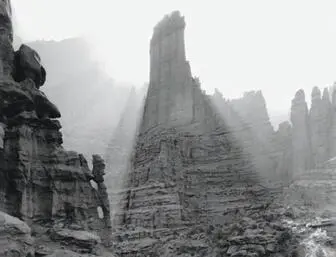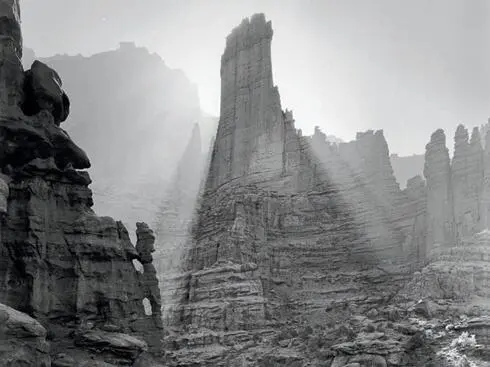Bruce Barnbaum - The Art of Photography - An Approach to Personal Expression
Здесь есть возможность читать онлайн «Bruce Barnbaum - The Art of Photography - An Approach to Personal Expression» весь текст электронной книги совершенно бесплатно (целиком полную версию без сокращений). В некоторых случаях можно слушать аудио, скачать через торрент в формате fb2 и присутствует краткое содержание. Жанр: Старинная литература, на английском языке. Описание произведения, (предисловие) а так же отзывы посетителей доступны на портале библиотеки ЛибКат.
- Название:The Art of Photography: An Approach to Personal Expression
- Автор:
- Жанр:
- Год:неизвестен
- ISBN:нет данных
- Рейтинг книги:5 / 5. Голосов: 1
-
Избранное:Добавить в избранное
- Отзывы:
-
Ваша оценка:
- 100
- 1
- 2
- 3
- 4
- 5
The Art of Photography: An Approach to Personal Expression: краткое содержание, описание и аннотация
Предлагаем к чтению аннотацию, описание, краткое содержание или предисловие (зависит от того, что написал сам автор книги «The Art of Photography: An Approach to Personal Expression»). Если вы не нашли необходимую информацию о книге — напишите в комментариях, мы постараемся отыскать её.
The Art of Photography: An Approach to Personal Expression — читать онлайн бесплатно полную книгу (весь текст) целиком
Ниже представлен текст книги, разбитый по страницам. Система сохранения места последней прочитанной страницы, позволяет с удобством читать онлайн бесплатно книгу «The Art of Photography: An Approach to Personal Expression», без необходимости каждый раз заново искать на чём Вы остановились. Поставьте закладку, и сможете в любой момент перейти на страницу, на которой закончили чтение.
Интервал:
Закладка:
Figure 10-7. Selective Burning or Flashing
You can refine the technique by flashing only the area that needs the boost rather than the entire image. First, focus the negative and find the area that requires flashing. Next, mark it off beside your easel using two cardboard arrowheads as markers of a Cartesian coordinate system (Figure 10-7). Then remove the negative and flash just the designated area, using the two-cardboard system described in the section on burning and shown in the diagram. In this way, only the area you want flashed (along with a little spillover to adjacent areas) will receive the additional blank exposure, and there will be no loss of contrast or muting of tonalities elsewhere.
How do you determine what is 7 units of light? Use the following method. With no negative in the carrier, close the lens aperture down to a minimum setting (f/22, f/32, or f/45—the smaller the better). Then make a test strip of blank light on the same grade paper as the print you are making, giving it one-second increments up to, say, 15 seconds. Then fully develop the strip. To be consistent with the discussion above, let’s say that the full 15 seconds of exposure shows a gray stripe, 14 seconds a lighter gray stripe, 13 seconds still lighter, and so on down to 10 seconds, which shows the last perceptible tonality. Now you know that 10 seconds is the threshold level of 10 units of light, so 7 seconds of flash exposure gives 7 units of light.
Of course, it’s a guess that the basic exposure gives us 4 units of light in the highlight. It could be 2 units or 9 units and still appear blank white in the final print. Thus, 7 units of flash exposure is also a guess, and several attempts may be necessary to determine the optimum amount of flash exposure. It may turn out that the best print involves a small amount of flash exposure after the basic exposure of the negative and some additional burning of the area. These three variables—basic exposure, burning, and flash exposure—must be juggled about to obtain the best result, but for a magnificent print, the result justifies the effort.
When I printed my negatives of English cathedrals on graded papers, I employed this technique frequently to get a full scale print of the interior architecture while maintaining detail on the stained glass. The windows, of course, are the light source for the interiors, and it’s not easy to get detail on a light source. In order to achieve what I wanted, I generally used a grade of paper with sufficiently high contrast to yield a full range of tones for the interior architecture, apart from the windows. Then I flashed (and often burned as well) to bring out detail in the windows. Without flashing, the windows printed as blank holes devoid of detail, and burning, alone, put an obvious halo around them.
Without flashing, the only approach I could have taken to print the cathedral negatives on graded paper would have been to print on a low contrast paper—making the interior dark, somber, and muted—while the window served as the sole source of brilliance. That would have been a legitimate interpretation, but it’s not how I saw or felt the cathedrals. Thus flashing provided a tool for me to interpret the cathedrals as I felt them.
In general, don’t exceed threshold in your flashing exposure. If threshold is equaled or exceeded, the highlight area will appear gray and dull rather than improved with detail. The whitest white within the highlight area should still remain white. In the cathedral prints, I wanted the clear glass portions of the windows to be pure white, but I wanted the colored glass—and especially the lead mullions separating the panes—to be plainly visible. If I had grayed the clear glass in flashing, the window would no longer appear to be the light source, and the light quality would have been lost.


In Figure 10-8, the background towers are brilliant, and the sunbeams streaming around the central tower are spectacular. However, the distant cliff wall to the left of the central tower is missing, while the blank white sky kills the image. Burning the sky at any contrast level creates problems due to the cliff, which gets too dark during burning. So, following the basic exposure, I remove the negative from the enlarger, close the aperture down to f/45, and add a two-stop neutral density filter from my enlarger. Using a convex-shaped card, I flash the sky downward from the upper corners, going well beyond threshold exposure and tapering to nothing halfway down each side, with far less flashing exposure in the center. In Figure 10-8, the gray sky tonalities are due to flashing, which is also enough to bring out the cliff wall while affecting the left edge of the cliff very little .
Figure 10-8. Sunburst, Fisher Towers
Flashing with Variable Contrast Papers
Variable contrast papers make flashing a rarely needed tool. Going back to printing my English cathedral studies, the task becomes far simpler with variable contrast papers rather than graded papers. The bright windows are the major problem. It is difficult to obtain detail on them while maintaining good contrast and brilliance in the rest of the interior. Using variable contrast paper I print for the interior, essentially ignoring the windows initially. I use a moderate to significant amount of magenta filtration to get the contrast level I want. Then I dial the magenta down to zero and dial up the yellow filtration to burn the windows. Burning the windows entails a bit of excess darkening of the adjacent stonework, but by burning at low contrast it is not darkened to the point that a halo appears.
If I did the burning at the same contrast level as the basic exposure, I would have the same problem that I had with graded paper. But the variable contrast allows me to burn at lower contrast levels, giving me a print almost identical to that of the graded paper print with a bit more tonal separation in the windows. This is due to burning at low contrast rather than flashing at no contrast. A further advantage of this procedure is that I don’t have to remove the negative from the enlarger to complete the print. Thus, the print is marginally improved and significantly easier to print.
While flashing is rarely used with variable contrast papers, it can still be a lifesaver. One example is a photograph I made in 1996 in Utah. On an unusually humid and hazy morning, the sun was coming up behind the imposing Fisher Towers northeast of Moab. From my camera position, the sun’s rays radiated out through the atmosphere, magnificently separating the near cliff and central tower from the distant cliffs and towers. But the entire sky was so much brighter than the backlit rocks that when I tried to print the image, the blank white sky killed it. Flashing saved it (Figure 10-8 and Figure 10-8)!
I used a burning card with a broad concave edge and flashed the upper part of the image, slowly moving the card up and down the sky and even partway down into the central tower and background cliffs. Little of the flash exposure hit the imposing tower in the center of the image because of the shape of the card, but progressively more affected the areas around and above that tower. At the corners, I exceeded threshold substantially, putting a pleasant gray tone into the sky and making it appear that the light was truly emanating from behind the central tower.
The portion of the tower that was exposed to the small amount of flashing showed no appreciable effect. But I could not have done it with burning, even at the lowest possible contrast level, because even the lowest possible contrast (i.e., the highest level of yellow filtration) still has some amount of contrast, whereas flashing has zero contrast. Printing at the highest level of yellow filtration produces an image; flashing at white light yields only levels of gray tonality.
Читать дальшеИнтервал:
Закладка:
Похожие книги на «The Art of Photography: An Approach to Personal Expression»
Представляем Вашему вниманию похожие книги на «The Art of Photography: An Approach to Personal Expression» списком для выбора. Мы отобрали схожую по названию и смыслу литературу в надежде предоставить читателям больше вариантов отыскать новые, интересные, ещё непрочитанные произведения.
Обсуждение, отзывы о книге «The Art of Photography: An Approach to Personal Expression» и просто собственные мнения читателей. Оставьте ваши комментарии, напишите, что Вы думаете о произведении, его смысле или главных героях. Укажите что конкретно понравилось, а что нет, и почему Вы так считаете.












